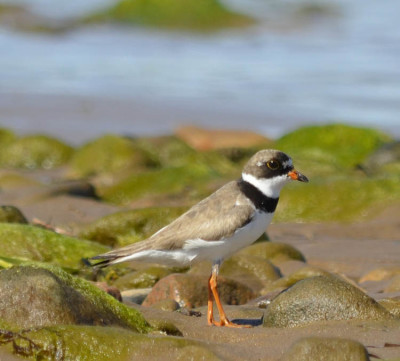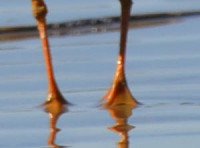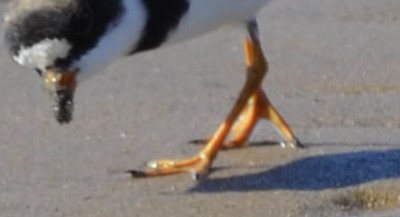During our vacation in Nova Scotia this past August we spent many days exploring beaches and rocky shorelines. We often found several small sandpiper type birds exploring those same shores. One type of bird had a brown back, white front, a wide black band like a necklace, yellow legs and a bill with some yellow on it. Although wary these birds would let us get fairly close before skimming out over the water and landing a dozen yards further up the beach. Or they would run along the sand keeping a wary eye on us. What were they?
Small Shorebirds with Short Bills are Often Plovers
I’m not a shorebird expert so I had to page carefully through all of the possibilities in my book. One thing I noticed that helps eliminate certain birds from the possibilities is the length of their bills. Apparently the varying beak lengths allow different types of birds to feed on organisms that live at different depths in the sand.
Plovers generally have fairly short bills.
My birds were also quite small, noticeably smaller than a robin but larger than a house sparrow.
The single black necklace, however, was the best field mark of all. Only a few shorebirds have a stripe of colour around their necks and across their upper chest. So it was easy to see these were Semipalmated Plovers.
If you squint at this plover’s feet you’ll see a clue to its name.
Another common shore bird with similar markings is a Killdeer. They are much larger, though, and have two black necklaces. They don’t have the vivid orange legs of the Semipalmated Plover either.
What Does Semipalmated Mean?
We first met these Plovers racing across the sand and waved smoothed small stones at Port Hood beach in Cape Breton. That led my children to nickname them Hoody Plovers because semipalmated is quite a mouthful.
Their curiousity led me to wonder what semipalmated means. According to Webster’s it’s a description of the bird’s feet. Semipalmated toes are joined together by a web, like a duck’s foot, but the web does not go all the way down the toes to their ends.
These photos show the partial webbing on the feet. It’s interesting (to me!) how the webbing is visible some of the time but much less obvious other times.
That information tied in with a “Cool Fact” from the AllAboutBirds website. The Cornell University site says that these plovers sometimes swim across small water channels rather than fly. Their chicks have been known to swim short distances to follow their parents. Swimming provides one reason why some webbing would be helpful for the birds.
Partial webbing can also help birds resist sinking into soft muddy ground. It’s like having a small pair of snowshoes on their feet. The Smithsonian National Zoological Park also believes that this is why the birds have this webbing.
When Can I Find these Plovers on the Beach?
Most of the shorebirds we saw on our trip were migrants returning from their near-Arctic breeding grounds. Yes, even though we were in Nova Scotia for the first three weeks of August, most of these birds had finished nesting up north and were on their way down south for the winter.
I was a bit surprised, though, to see on the AllAboutBirds website that Semipalmated Plovers also nest in Nova Scotia and Newfoundland. So the birds we saw could be migrants or summer residents. They could even have been (and probably were) a mixture of both.
At Port Hood beach, the signage says that Semipalmated are only transient not resident their. So I guess those birds were ones that had already winged their way southwards.
In August and early September, Semipalmated Plovers can be found almost everywhere in Canada as they migrate.
This was probably a flock of migrating plovers.
What Do Semipalmateds Feed On?
I did notice when we first watched these small plovers that they don’t “sew” their way along the sandy beach. Some sandpipers spend most of their time with their bills buried probing for worms, invertebrates and crustaceans.
Instead, these plovers would run a few steps, stop, look and listen, then pick up something with their bill. Sometimes they probed into the sand, other times they ate something off of the surface.
According to my bird books and the websites, Semipalmated Plovers eat large numbers of insects. They also eat invertebrates especially while on migration.
Social but not Flocking
On many of the shores, we saw 10 to 100 Semipalmated Plovers. They didn’t particularly flock together though. They spread out across the shore each searching for food.
Occasionally, though, we would see a group flying together, often mixed with other types of shorebirds. So they seem social but did not seem worried about being solitary either. In fact twice at Port Hood I saw an adult “chase away” another adult who approached too closely before going back to feeding.
I hope to see more of these attractive plovers on future trips. Maybe if we travel in July I’ll be able to see some of the resident plovers—and their chicks!
Related Reading
Join In
Have you seen any of these “hoody” plovers in your neighbourhood? Did you think they were killdeer until you got a closer look? Please share your experiences with a comment.






I saw a group of these Plovers at Bombay Hook National Wildlife Refuge in Delaware on Friday (Aug. 30). They were feeding in a shallow area of one of the small ponds.
Thank you for sharing!